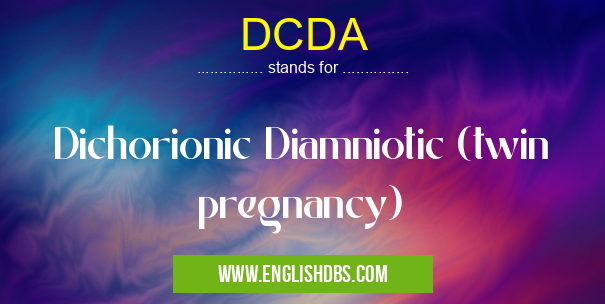What does DCDA mean in PHYSIOLOGY
DCDA stands for Dichorionic Diamniotic, a medical term used to describe a type of twin pregnancy. It refers to a situation where the twins have separate placentas and separate amniotic sacs.

DCDA meaning in Physiology in Medical
DCDA mostly used in an acronym Physiology in Category Medical that means Dichorionic Diamniotic (twin pregnancy)
Shorthand: DCDA,
Full Form: Dichorionic Diamniotic (twin pregnancy)
For more information of "Dichorionic Diamniotic (twin pregnancy)", see the section below.
» Medical » Physiology
Types of Twin Pregnancies
- Monochorionic Monoamniotic (MCMA): Twins share both the placenta and the amniotic sac.
- Monochorionic Diamniotic (MCDA): Twins share the placenta but have separate amniotic sacs.
- Dichorionic Diamniotic (DCDA): Twins have separate placentas and separate amniotic sacs.
Characteristics of DCDA Pregnancies
- Each twin has its own placenta, providing independent nutrition and oxygen supply.
- Each twin is enclosed in its own amniotic sac, filled with amniotic fluid for protection.
- Twins may be of the same or opposite sex.
- The placentas may be located close together or far apart.
Significance of DCDA
- Lower Risk of Complications: Compared to MCMA and MCDA pregnancies, DCDA has a lower risk of complications such as fetal growth restriction, premature birth, and birth defects.
- Independent Fetal Growth: Each twin has its own placenta and amniotic sac, allowing for independent growth and development.
- Fewer Fetal Interactions: Twins are physically separated, reducing the risk of entanglements or other fetal interactions.
Essential Questions and Answers on Dichorionic Diamniotic (twin pregnancy) in "MEDICAL»PHYSIOLOGY"
What is a DCDA twin pregnancy?
DCDA stands for Dichorionic Diamniotic, which refers to a type of twin pregnancy where the twins have separate placentas and separate amniotic sacs. This means that the twins are not identical and do not share the same genetic material.
How common are DCDA twin pregnancies?
DCDA twin pregnancies are the most common type of twin pregnancy, accounting for approximately 70% of all twin pregnancies.
What are the risks associated with DCDA twin pregnancies?
DCDA twin pregnancies are generally considered to be lower risk than other types of twin pregnancies, such as monochorionic diamniotic (MCDA) pregnancies. However, there are still some risks associated with DCDA twin pregnancies, including:
- Preterm birth
- Low birth weight
- Twin-to-twin transfusion syndrome (TTTS)
- Fetal growth restriction
How are DCDA twin pregnancies managed?
DCDA twin pregnancies are typically managed with regular prenatal care and monitoring. The doctor will closely monitor the growth and development of both twins and will perform regular ultrasounds to check for any complications.
What is the prognosis for DCDA twin pregnancies?
The prognosis for DCDA twin pregnancies is generally good. Most DCDA twins are born healthy and without any major complications.
Final Words: DCDA (Dichorionic Diamniotic) is a type of twin pregnancy characterized by separate placentas and separate amniotic sacs for each twin. This configuration reduces the risk of complications compared to other types of twin pregnancies and allows for independent fetal growth and development.
